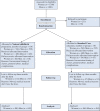Effects of natural childbirth preparation versus standard antenatal education on epidural rates, experience of childbirth and parental stress in mothers and fathers: a randomised controlled multicentre trial
- PMID: 19538406
- PMCID: PMC2759981
- DOI: 10.1111/j.1471-0528.2009.02144.x
Effects of natural childbirth preparation versus standard antenatal education on epidural rates, experience of childbirth and parental stress in mothers and fathers: a randomised controlled multicentre trial
Abstract
Objective: To examine the effects of antenatal education focussing on natural childbirth preparation with psychoprophylactic training versus standard antenatal education on the use of epidural analgesia, experience of childbirth and parental stress in first-time mothers and fathers.
Design: Randomised controlled multicentre trial.
Setting: Fifteen antenatal clinics in Sweden between January 2006 and May 2007.
Sample: A total of 1087 nulliparous women and 1064 of their partners.
Methods: Natural group: Antenatal education focussing on natural childbirth preparation with training in breathing and relaxation techniques (psychoprophylaxis). Standard care group: Standard antenatal education focussing on both childbirth and parenthood, without psychoprophylactic training. Both groups: Four 2-hour sessions in groups of 12 participants during third trimester of pregnancy and one follow-up after delivery.
Main outcome measures: Epidural analgesia during labour, experience of childbirth as measured by the Wijma Delivery Experience Questionnaire (B), and parental stress measured by the Swedish Parenthood Stress Questionnaire.
Results: The epidural rate was 52% in both groups. There were no statistically significant differences in the experience of childbirth or parental stress between the randomised groups, either in women or men. Seventy percent of the women in the Natural group reported having used psychoprophylaxis during labour. A minority in the Standard care group (37%) had also used this method, but subgroup analysis where these women were excluded did not change the principal findings.
Conclusion: Natural childbirth preparation including training in breathing and relaxation did not decrease the use of epidural analgesia during labour, nor did it improve the birth experience or affect parental stress in early parenthood in nulliparous women and men, compared with a standard form of antenatal education.
Figures
Comment in
-
Study finds no differences between groups using natural childbirth methods versus standard childbirth education in choice of epidural anesthesia.J Midwifery Womens Health. 2010 May-Jun;55(3):290-1. doi: 10.1016/j.jmwh.2010.02.003. J Midwifery Womens Health. 2010. PMID: 20434096 No abstract available.
-
Natural childbirth vs antenatal education.Midwives. 2009 Aug-Sep;12(4):21. Midwives. 2009. PMID: 24902224 No abstract available.
References
-
- Fabian HM, Radestad IJ, Waldenstrom U. Characteristics of Swedish women who do not attend childbirth and parenthood education classes during pregnancy. Midwifery. 2004;20:226–35. - PubMed
-
- Dick-Read G. Childbirth Without Fear: The Principles and Practice of Natural Childbirth. New York, London: Harper & Brothers Publishers, Pinter & Martin; 2004. 1944.
-
- Lamaze F. Painless Childbirth : The Lamaze Method. Chicago, IL: Contemporary Books; 1984. 1956.
-
- Velvovsky IPK, Ploticher V, Shugom E. Painless Childbirth Through Psychoprophylaxis. Moscow: Foreign Languages Publishing House; 1960.
-
- Fabian HM, Radestad IJ, Waldenstrom U. Childbirth and parenthood education classes in Sweden. Women’s opinion and possible outcomes. Acta Obstet Gynecol Scand. 2005;84:436–43. - PubMed
Publication types
MeSH terms
LinkOut - more resources
Full Text Sources
Medical



